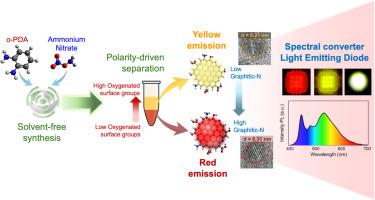用于LED光谱转换的黄到红发射碳点的快速无溶剂合成
IF 5.1
3区 材料科学
Q2 MATERIALS SCIENCE, COATINGS & FILMS
引用次数: 0
摘要
开发了一种快速、无溶剂、微波辅助的策略来合成具有固有黄到红发射的碳点(cd),使其能够直接用于LED光谱转换。值得注意的是,这种绿色方法可以在大约1分钟内形成黄色到红色的发射cd,而不使用任何溶剂,与传统的湿化学方法相比,突出了高度可持续和时间效率的路线。热处理后的CDs具有不同的氮和氧表面基团,产生可分离的发射组分。黄色和红色发光(y-CDs和r-CDs)通过离心从单个合成批中分离出来,由表面极性驱动。石墨- n是调制发射红移的关键构型,得到了结构分析和计算分析的支持。与y-CDs (~ 0.21 nm)相比,r-CDs具有更宽的晶格条纹(~ 0.31 nm),并且石墨- n和吡啶- n含量大约是y-CDs (~ 0.21 nm)的两倍,y-CDs含有更高的氧水平和吡啶- n优势。时间依赖密度泛函理论(TD-DFT)计算表明,只有石墨- n显著缩小了HOMO-LUMO间隙,引起发射光谱的移位。偶极矩和亲电性指数的计算为极性驱动的发射组分分离提供了机制上的洞察。当嵌入透明聚合物基质时,CDs表现出适度的光稳定性,并启用高效的黄色,红色和白色发光二极管(led)。白光LED的CIE坐标为(0.312,0.353),显色指数为88,CCT为6376 K,产生明亮的冷白光。这项工作建立了一个快速、绿色的广谱发射CDs合成平台,阐明了氮驱动发射调谐和极性分离的机制框架,并扩展了碳基荧光团在光谱转换和荧光传感应用中的分析潜力。本文章由计算机程序翻译,如有差异,请以英文原文为准。

Rapid solvent-free synthesis of carbon dots with yellow to red emission for LED spectral conversion
A rapid and solvent-free, microwave-assisted strategy was developed to synthesize carbon dots (CDs) exhibiting intrinsic yellow-to-red emission, enabling their direct use in LED spectral conversion. Remarkably, this green approach enables the formation of yellow to red emissive CDs within approximately 1 min, without the use of any solvents, highlighting a highly sustainable and time-efficient route compared to conventional wet-chemical methods. The thermal treatment yielded CDs with diverse nitrogen and oxygen surface groups, producing separable emissive fractions. Yellow and red-emitting (y-CDs and r-CDs) were isolated from a single synthetic batch via centrifugation, driven by surface polarity. Graphitic-N emerged as the key configuration modulating the emission redshift, supported by both structural and computational analyses. The r-CDs exhibited broader lattice fringes (∼0.31 nm) and approximately twice the graphitic-N and pyridinic-N content compared to y-CDs (∼0.21 nm), which contained higher oxygen levels and pyrrolic-N dominance. Time-dependent density functional theory (TD-DFT) calculations revealed that only graphitic-N significantly narrows the HOMO–LUMO gap, inducing a shift in emission spectra. Dipole moment and electrophilicity index calculations provided mechanistic insight into polarity-driven separation of the emissive fractions. When embedded into transparent polymer matrices, the CDs demonstrated moderate photostability and enabled efficient yellow, red, and white light-emitting diodes (LEDs). The white LED exhibited CIE coordinates of (0.312, 0.353), CRI of 88, and a CCT of 6376 K, producing bright, cool-white light. This work establishes a rapid, green synthesis platform for broad-spectrum emissive CDs, elucidates a mechanistic framework for nitrogen-driven emission tuning and polarity-based separation, and expands the analytical potential of carbon-based fluorophores for spectral conversion and fluorescence-based sensing applications.
求助全文
通过发布文献求助,成功后即可免费获取论文全文。
去求助
来源期刊

Diamond and Related Materials
工程技术-材料科学:综合
CiteScore
6.00
自引率
14.60%
发文量
702
审稿时长
2.1 months
期刊介绍:
DRM is a leading international journal that publishes new fundamental and applied research on all forms of diamond, the integration of diamond with other advanced materials and development of technologies exploiting diamond. The synthesis, characterization and processing of single crystal diamond, polycrystalline films, nanodiamond powders and heterostructures with other advanced materials are encouraged topics for technical and review articles. In addition to diamond, the journal publishes manuscripts on the synthesis, characterization and application of other related materials including diamond-like carbons, carbon nanotubes, graphene, and boron and carbon nitrides. Articles are sought on the chemical functionalization of diamond and related materials as well as their use in electrochemistry, energy storage and conversion, chemical and biological sensing, imaging, thermal management, photonic and quantum applications, electron emission and electronic devices.
The International Conference on Diamond and Carbon Materials has evolved into the largest and most well attended forum in the field of diamond, providing a forum to showcase the latest results in the science and technology of diamond and other carbon materials such as carbon nanotubes, graphene, and diamond-like carbon. Run annually in association with Diamond and Related Materials the conference provides junior and established researchers the opportunity to exchange the latest results ranging from fundamental physical and chemical concepts to applied research focusing on the next generation carbon-based devices.
 求助内容:
求助内容: 应助结果提醒方式:
应助结果提醒方式:


